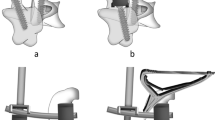Abstract
Objective and importance
The entry point and trajectory are very important for transarticular screw (TAS) and C2 pedicle screw (PDS) plantation. When the physical size is not large enough for the screw passing through, an accurate entry point is the most important point for successful screw insertion without vertebral artery (VA) injury and spinal cord injury. Once the laminas of C2 and C3 are fused, the normal anatomic mark might disappear and the insertion point would be hard to find. As a result, the complication of TAS or PDS implantation increases rapidly. We used C2 translaminar screws (TLSs) with C1 lateral mass screws as the optimal fixation for atlantoaxial dislocation in order to reduce the risk of VA injury and spinal cord injury.
Clinical presentation
A 37-year-old woman with atlantoaxial dislocation due to obsolete odontoid fracture complained of neck pain and myelopathy. Preoperative CT reconstruction showed C2–C3 fusion and small size of C2 isthmus.
Technique
The patient underwent posterior atlantoaxial fusion using C1 lateral mass screws and C2 TLSs. The posterior arch of atlas was removed for decompression and fusion was done at C1–C2 joints by grafting bone fragments from the posterior iliac crest.
Conclusion
TLSs combined with C1 lateral mass screws might be a useful technique for patients with atlantoaxial dislocation and C2–C3 fusion, especially with small size of C2 isthmus. Also, the fusion of posterior elements between C2 and C3 might be a relative contraindication for TAS fixation.


Similar content being viewed by others
References
Dickman CA, Crawford NR, Paramore CG (1996) Biomechanical characteristics of C1–2 cable fixations. J Neurosurg 85:316–322. doi:10.3171/jns.1996.85.2.0316
Grob D, Crisco JJ 3rd, Panjabi MM, Wang P, Dvorak J (1992) Biomechanical evaluation of four different posterior atlantoaxial fixation techniques. Spine (Phila Pa 1976) 17:480–490
Haid RW Jr, Subach BR, McLaughlin MR, Rodts GE Jr, Wahlig JB Jr (2001) C1–C2 transarticular screw fixation for atlantoaxial instability: a 6-year experience. Neurosurgery 49:65–68 (discussion 69–70)
Madawi AA, Casey AT, Solanki GA, Tuite G, Veres R, Crockard HA (1997) Radiological and anatomical evaluation of the atlantoaxial transarticular screw fixation technique. J Neurosurg 86:961–968. doi:10.3171/jns.1997.86.6.0961
Grob D, Jeanneret B, Aebi M, Markwalder TM (1991) Atlanto-axial fusion with transarticular screw fixation. J Bone Joint Surg Br 73:972–976
Ludwig SC, Kowalski JM, Edwards CC 2nd, Heller JG (2000) Cervical pedicle screws: comparative accuracy of two insertion techniques. Spine (Phila Pa 1976) 25:2675–2681
Karaikovic EE, Yingsakmongkol W, Gaines RW Jr (2001) Accuracy of cervical pedicle screw placement using the funnel technique. Spine (Phila Pa 1976) 26:2456–2462
Wright NM (2004) Posterior C2 fixation using bilateral, crossing C2 laminar screws: case series and technical note. J Spinal Disord Tech 17:158–162
Sugimoto Y, Tanaka M, Nakanishi K, Misawa H, Takigawa T, Ito Y, Ozaki T (2009) Safety of atlantoaxial fusion using laminar and transarticular screws combined with an atlas hook in a patient with unilateral vertebral artery occlusion (case report). Arch Orthop Trauma Surg 129:25–27. doi:10.1007/s00402-007-0510-9
Lehman RA Jr, Dmitriev AE, Helgeson MD, Sasso RC, Kuklo TR, Riew KD (2008) Salvage of C2 pedicle and pars screws using the intralaminar technique: a biomechanical analysis. Spine (Phila Pa 1976) 33:960–965. doi:10.1097/BRS.0b013e31816c915b
Solanki GA, Crockard HA (1999) Peroperative determination of safe superior transarticular screw trajectory through the lateral mass. Spine (Phila Pa 1976) 24:1477–1482
Lee JH, Jahng TA, Chung CK (2007) C1–2 transarticular screw fixation in high-riding vertebral artery: suggestion of new trajectory. J Spinal Disord Tech 20:499–504. doi:10.1097/BSD.0b013e318031af51
Igarashi T, Kikuchi S, Sato K, Kayama S, Otani K (2003) Anatomic study of the axis for surgical planning of transarticular screw fixation. Clin Orthop Relat Res 2003:162–166
Ebraheim N, Rollins JR Jr, Xu R, Jackson WT (1996) Anatomic consideration of C2 pedicle screw placement. Spine (Phila Pa 1976) 21:691–695
Leonard JR, Wright NM (2006) Pediatric atlantoaxial fixation with bilateral, crossing C-2 translaminar screws. Technical note. J Neurosurg 104:59–63. doi:10.3171/ped.2006.104.1.59
Gorek J, Acaroglu E, Berven S, Yousef A, Puttlitz CM (2005) Constructs incorporating intralaminar C2 screws provide rigid stability for atlantoaxial fixation. Spine 30:1513–1518.
Richter M, Schmidt R, Claes L, Puhl W, Wilke HJ (2002) Posterior atlantoaxial fixation: biomechanical in vitro comparison of six different techniques. Spine 27:1724–1732
Lapsiwala SB, Anderson PA, Oza A, Resnick DK (2006) Biomechanical comparison of four C1 to C2 rigid fixative techniques: anterior transarticular, posterior transarticular, C1 to C2 pedicle, and C1 to C2 intralaminar screws. Neurosurgery 58:516–521. doi:10.1227/01.NEU.0000197222.05299.31 (discussion 516–521)
Lehman RA Jr, Sasso RC, Helgeson MD, Dmitriev AE, Gill NW, Rosner MR, Riew KD (2007) Accuracy of intraoperative plain radiographs to detect violations of intralaminar screws placed into the C2 vertebrae: a reliability study. Spine (Phila Pa 1976) 32:3036–3040. doi:10.1097/BRS.0b013e31815cdab9
Author information
Authors and Affiliations
Corresponding author
Rights and permissions
About this article
Cite this article
Zhou, F., Ni, B., Li, S. et al. C2 translaminar screw as the optimal choice for atlantoaxial dislocation with C2–C3 congenital fusion. Arch Orthop Trauma Surg 130, 1505–1509 (2010). https://doi.org/10.1007/s00402-010-1069-4
Received:
Published:
Issue Date:
DOI: https://doi.org/10.1007/s00402-010-1069-4




